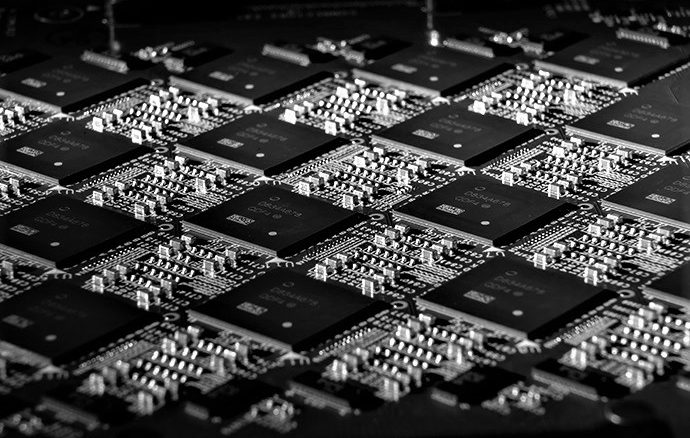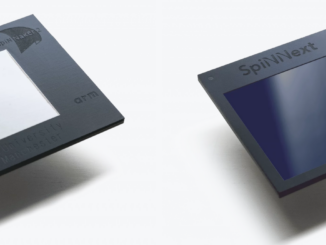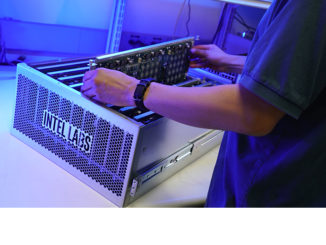
Intel has moved a step closer to commercial neuromorphic computing with the development of a 64-chip system that provides eight million artificial neurons. Codenamed Pohoiki Beach, the system represents the chipmaker’s first attempt at scaling its Loihi processor technology into more powerful neuromorphic computing platforms.
Pohoiki Beach is based on Intel’s Nahuku boards, each of which contains eight to 32 Loihi processors. That means the current 64-processor system is built from between two and eight boards, although Intel is not offering details of the exact configuration, including how the chips and boards are networked together.
Loihi, which Intel unveiled in 2017, provides the equivalent of 130,000 neurons and 130 million synapses, implemented as a manycore mesh. Each core contains a “learning engine” that can support different many types of AI models, including supervised, unsupervised, and reinforcement learning, among others. According to Intel, Loihi is about 1,000 times faster and 10,000 times more efficient than CPUs for applications like sparse coding, graph search and constraint-satisfaction problems. The chip has been available to researchers through the Intel Neuromorphic Research Community (INRC) via a cloud service and as the Kapoho Bay platform, a Loihi-based USB form factor device.
Like IBM’s TrueNorth processor and other versions of neuromorphic hardware, Loihi relies on spiking neurons networks to emulate the way biological brains process information. One of the big advantages of this type of computing model is the low amount of power drawn by these chips compared to conventional von Neuman processors. Potentially, that could bring the technology into areas like IoT, mobile devices, and edge computing, where high-powered AI hardware is currently lacking.
According to Intel, Pohoiki Beach is aimed at some of the toughest challenges in computer science, such as sparse coding, simultaneous localization and mapping (SLAM), and path planning. These types of applications can be performed on conventional computers, but they are not very efficient at it, at least on a performance-per-watt basis. For example, SLAM applications are generally used in power-constrained systems like autonomous vehicles, robotics, and virtual reality devices. To be able to handle this type of workload efficiently in such environments, especially for real-time applications, requires something akin to a brain-like inference capability.
In that regard, experience with Intel’s neuromorphic technology looks promising. According to Konstantinos Michmizos of Rutgers University, his team was able to construct a highly energy-efficient SLAM solution based on the Loihi technology. “We benchmarked the Loihi-run network and found it to be equally accurate while consuming 100 times less energy than a widely used CPU-run SLAM method for mobile robots,” said Michmizos.
In a similar vein, Chris Eliasmith, co-CEO of Applied Brain Research and professor at University of Waterloo, said that researchers were able to demonstrate 109 times lower power consumption than a GPU running a real-time deep learning benchmark and five times lower power consumption than specialized IoT inference hardware. “Even better, as we scale the network up by 50 times, Loihi maintains real-time performance results and uses only 30 percent more power, whereas the IoT hardware uses 500 percent more power and is no longer real-time,” he said.
Other Loihi-powered applications were presented at the Telluride Neuromorphic Cognition Engineering Workshop this week. These included projects that used the technology to provide a controller for a prosthetic leg, object tracking for event-based cameras, automation for a foosball table with neuromorphic sensing and control, a learning system to control a linear inverted pendulum, and tactile sensing capability for the electronic skin of an iCub robot.
With Pohoiki Beach, researcher likes these will now have access to a much more powerful platform that can be tested for scaled-up applications. Later this year, Intel is intending to provide an even larger system, which will be codenamed Pohoiki Springs. That machine will provide 100 million neurons, providing an order of magnitude increase over Pohoiki Beach. Assuming the same Loihi hardware is used, Pohoiki Springs will need 800 such chips to reach the 100 million neuron milestone.
By raw numbers, the Pohoiki Beach and Pohoiki Springs systems are dwarfed by SpinNNaker’s largest machine, which boasts a billion neurons. It used about 50,000 chips to achieve this. SpinNNaker, however, is more of a pure research project whose goal is to simulate the workings of the brain. It’s currently being funded by the European Human Brain Project
To put all that in some context, the human brain has about 100 billion neurons, so Pohoiki Springs would represent about a tenth of a percent of that and the SpiNNaker system about one percent. Intel has no plans at this point to replicate the human brain though. According to the company, all of their work is laying the groundwork for commercialization of the technology, although Intel yet to provide a timeline of when they think production-ready systems will be available.





Be the first to comment